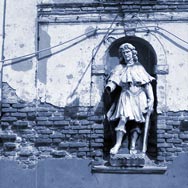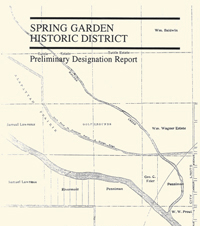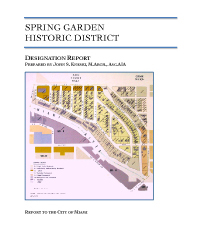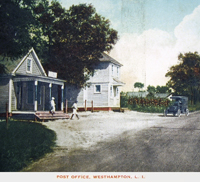historic preservation
Spring Garden Historic District, 1994-1997: District Planner / Designation Project Coordinator
Miami, Florida - One of the City of Miami’s four officially designated historic districts.
Responsible for producing and presenting the historic survey and the Historic District Designation Report to the City of Miami Planning Department. Successfully lobbied:• Local, regional and state preservation organizations for designation endorsement.
• State representatives for historic district and parks formation
• The City of Miami for repair to historic amenities.
• Miami-Dade County for the creation of a new park.
• The State of Florida DOT for new planting of trees alongside the district.Spring Garden Historic District
Years Built: 1920-present
Date Designated: 1997Much of the history of Spring Garden predates its initial subdivision in 1918. Crucial in this history is the area's location between two bodies of water, the Miami River and Wagner Creek (now the Seybold Canal). Wagner Creek was one of the main natural tributaries of the Miami River and joined the river approximately one and one-half miles from Biscayne Bay. The first structure in today's Spring Garden was a coontie starch mill built on Wagner Creek by William English in the late 1840's. William Wagner and a Captain Sinclair also built a steam-powered coontie mill on Wagner Creek in the late 1850's, perhaps on the same site of English's earlier mill. The area's first known house was located at Penniman Spring, near Wagner Creek and today’s Northwest Ninth Street.
Tumlin - Pearson House Restoration Project, 1994-96
Spring Garden, Miami, Florida
Project architect. Complete renovation of a 4,300 sq ft, circa 1925 mission style house in Dade County’s most historically significant neighborhood. House occupies land that was one of Miami's early dairy farms along the Miami River. The house - one of the original in the subdivision - was later occupied by one of Miami's first doctors. Project involved extensive historical research and detailed analysis of construction and finishes. Spring Garden was advertised as “the most exclusive subdivision in Miami” when the first lots were offered for sale in 1919. Deed restrictions attached to the sale of each lot have helped preserve the character of the neighborhood, which includes Frame and Masonry Vernacular houses along with examples of Craftsman, Mission, and Streamline Moderne style homes built from the 1920s to the 1940s.Silverstein House Restoration, 2000
Shenandoah Neighborhood, Miami, FloridaProject architect. Complete renovation of a circa 1930 mission style cottage in one of Miami's historic neighborhoods. Project involved restoration of original finishes and extensive landscape design.
"The Shenandoah neighborhood has not only reclaimed its identity, but steadily improved its standing as a desirable and safe place to live. Demand for the homes has remained steady even in the economic free fall in which this city, along with the rest of the country, now finds itself. The area is increasingly prized for its historic architecture and central location..." ~ Paul Hampton Crockett
Haberland House Restoration, 2005
Vanderbilt Park, Westhampton, New YorkProject architect. Complete renovation of a circa 1930 Cape Cod style cottage in one of Southampton Township’s historically significant neighborhoods. Project involved extensive historical research and detailed analysis of construction and finishes.
Borrowing from the tiny New England homes of the 17th century, this cottage style has consistently appealed to generations of Americans for it's simplicity and charm. Like other Colonial Revival styles, it has a rectangular footprint, but a steeper gabled roof. Plainer in ornamentation that than many other Colonial styles, the Cape Cod was ideally suited to summer homes. They found favor across the country for their affordability, especially during the Depression years from 1930 to 1940. With this traditional form, it was possible to build a "half" Cod and add to it as funds became available, which is what was achieved through this project.
Vanderbilt Park History Project
Westhampton, New YorkHistoric preservation publication project under way in one of Southampton Township's early twentieth century neighborhoods.
"Westhampton, or Catchaponack as it was named by the Algonquin tribes in the 1660s, is revealed to be not only a beautiful and scenic area, but an area whose inhabitants and residents have survived and overcome hurricanes, civil and world wars, and other life altering circumstances, and to have grown and flourished from agricultural and fishing villages to what is now considered to be one of the most desirable summer vacation resorts on the East End." ~ Eileen Casey







